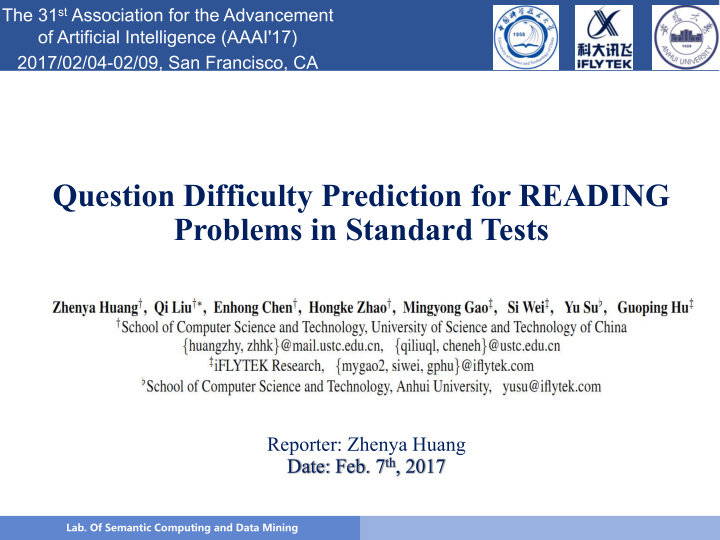



The 31 st Association for the Advancement of Artificial Intelligence (AAAI'17) 2017/02/04-02/09, San Francisco, CA Question Difficulty Prediction for READING Problems in Standard Tests Reporter: Zhenya Huang Date: Feb. 7 th , 2017 ����������������� ��.���������������������
Outline ��.������������������������ � ������������������ � ����A��������� � � ������������� � ����������� � ���.���������������������� � ���������������.��������������������������
Background Ø In widely used standard tests, such as TOEFL, examinees are often allowed to retake tests and choose higher scores for college admission. Ø Fairness requirement : select test papers with consistent difficulties. Ø Test Measurements have attracted much attention. Ø Crucial demand : question difficulty prediction (QDP) ����������������� ��.���������������������
What is question difficulty? Ø Following Educational Psychology, question difficulty refers to the percentage of examinees who answer the question wrong. (T1) Q1: (1+0)/2=0.5 (T1) Q2: 0 (T2) Q3: 0.33 ����������������� ��.���������������������
Background Ø Traditional solutions resort to expertise Ø Experts Labeling Ø Subjective Ø Biases on different experts, thus sometimes misleading Ø Artificial test organization Ø Labor intensive Ø Confidentiality Ø Human-based solutions cannot applied to large-scale Question Difficulty Prediction (QDP) ����������������� ��.���������������������
Research Problem Ø Urgent issue: Question Difficulty Prediction (QDP) Ø How to automatically predict question difficulty without manual intervention ? Ø Opportunity Ø Historical test logs of examinees Ø Text materials of questions Ø This paper focuses on English Reading Problems ����������������� ��.���������������������
Challenge 1 for QDP Ø Requires an unified way to understand and represent them from a semantic perspective. Ø Multiple parts of question texts Ø Document (TD) Ø Question (TQ) Ø Options (TO) ����������������� ��.���������������������
Challenge 2 for QDP Ø It is necessary and hard to distinguish the importance of text materials to a specific question Ø Different questions concern different parts of texts Ø Q1 concentrates more on the highlighted “blue” Ø Q2 focuses more on the “green” ����������������� ��.���������������������
Challenge 3 for QDP Ø It is necessary to take these difficulty biases into consideration for question difficulty prediction Ø Different questions are incomparable in different tests Ø Q2 with difficulty 0.6 in T1 Ø Q1 with difficulty 0.37 in T2 ����������������� ��.���������������������
Related Work for QDP Ø Education Psychology Take a lot of human effort. Ø Possible factors contributed to question difficulty Not an automatic solution. Ø Question attributes, i.e., question types (structures) Ø Examinee knowledge mastering degree Ø Cognitive Diagnosis Assessment (CDA) Ø Question difficulty obtained from examinees’ responses Ø Nature Language Process Ø Understanding and representations of all text materials Ø ����������������� Ø ������������������ Machine abilities V.S. Ø ��������������������� Question difficulty e.g., word reasoning ����������������� ��.���������������������
Outline ��.������������������������ � ������������������ � ����A��������� � � ������������� � ����������� � ���.���������������������� � ���������������.��������������������������
Problem Definition Ø Given: questions of READING problems with corresponding text materials Ø Given: historical examinees’ test logs. Ø Goal: Automatically predict question difficulty in newly-conduct tests ����������������� ��.���������������������
Outline ��.������������������������ � ������������������ � ����A��������� � � ������������� � ����������� � ���.���������������������� � ���������������.��������������������������
Study Overview Ø Two-stage solution Ø Training stage Ø TACNN Ø Training strategy Ø Testing stage Ø Predict difficulty ����������������� ��.���������������������
Outline ��.������������������������ � ������������������ � ����A��������� � � ������������� � ����������� � ���.���������������������� � ���������������.��������������������������
TACNN Framework Ø Test-dependent Attention-based Convolutional Neural Network (TACNN) Challenge 1: Ø Learning all text materials of each question from a unified way sentence semantic perspective — CNN-based architecture Ø Learns attention representations for each question by Challenge 2: qualify qualifying the contributions of its text materials contributions — Attention strategy Ø Wipe out the difficulty biases in different tests for Challenge 3: Difficulty training biases — Test-dependent strategy ����������������� ��.���������������������
TACNN Framework Ø Four Layers D ����������������� ��.���������������������
TACNN Framework – Input Ø Goal: learn sentence representations from word perspective Ø For each question (Text materials) Ø Document (TD) Ø Sequence sentences Ø Question (TQ) Ø One sentence Ø Options (TO) D Ø Four sentences Ø For each sentence Ø Sequence words Ø For each word Ø Embedding ����������������� ��.���������������������
TACNN Framework – Sentence CNN Ø Goal: learn sentence representations from semantic perspective Ø CNN-based architecture Ø Capture dominated information = Reading habit Ø Learn deep comparable semantic representations Ø Reduces the model complexity ����������������� ��.���������������������
TACNN Framework – Sentence CNN Ø A variant of traditional CNN Ø Four Convolution (3 wide + 1 narrow) Ø Four pooling ����������������� ��.���������������������
TACNN Framework - Attention Layer Ø Goal: Ø Qualify the contributions of text materials to a specific question Ø Learn the attention representations Ø Considering both documents and options level Attention score Attention vector ����������������� ��.���������������������
TACNN Framework – Predict Layer Ø Goal: predicting question difficulty Ø Document attention vector Ø Option attention vector Ø Question vector Question vector Document attention vector Option attention vector ����������������� ��.���������������������
TACNN — training strategy Ø How to train? Ø Supervised way: leverage historical test logs of examinees ����������������� ��.���������������������
Recommend
More recommend